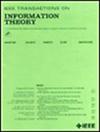Kendall τ -Metric下排列码大小的改进界
IF 2.9
3区 计算机科学
Q3 COMPUTER SCIENCE, INFORMATION SYSTEMS
引用次数: 0
摘要
为了克服快闪记忆带来的挑战,也为了防止霰弹枪测序方法中与读取DNA分子中存储的信息有关的错误,提出了秩调制方法。在秩调制框架中,码字是排列。本文研究了长度为n的排列码的最大大小$P(n, d)$,即在Kendall $\tau $ -metric下,$\{1,\ldots , n\}$上所有排列集$S_{n}$的最小距离至少为$d\in \left \{{{1,\ldots ,\binom {n}{2}}}\right \}$的子集。通过给出一个算法和两个定理,我们改进了已知的$P(n,d)$的下界和上界。特别地,我们为所有$n\geq 6$和$\frac {3}{5}\binom {n}{2}\lt d \leq \frac {2}{3} \binom {n}{2}$显示$P(n,d)=4$。另外,我们证明了对于任意素数n和整数$r\leq \frac {n}{6}$, $ P(n,3)\leq (n-1)!-\dfrac {n-6r}{\sqrt {n^{2}-8rn+20r^{2}}}\sqrt {\dfrac {(n-1)!}{n(n-r)!}}$。这个结果极大地改善了所有质数$n\geq 37$的$P(n,3)$上界。本文章由计算机程序翻译,如有差异,请以英文原文为准。
Improved Bounds on the Size of Permutation Codes Under Kendall τ -Metric
In order to overcome the challenges caused by flash memories and also to protect against errors related to reading information stored in DNA molecules in the shotgun sequencing method, the rank modulation method has been proposed. In the rank modulation framework, codewords are permutations. In this paper, we study the largest size $P(n, d)$ of permutation codes of length n, i.e., subsets of the set $S_{n}$ of all permutations on $\{1,\ldots , n\}$ with the minimum distance at least $d\in \left \{{{1,\ldots ,\binom {n}{2}}}\right \}$ under the Kendall $\tau $ -metric. By presenting an algorithm and two theorems, we improve the known lower and upper bounds for $P(n,d)$ . In particular, we show that $P(n,d)=4$ for all $n\geq 6$ and $\frac {3}{5}\binom {n}{2}\lt d \leq \frac {2}{3} \binom {n}{2}$ . Additionally, we prove that for any prime number n and integer $r\leq \frac {n}{6}$ , $ P(n,3)\leq (n-1)!-\dfrac {n-6r}{\sqrt {n^{2}-8rn+20r^{2}}}\sqrt {\dfrac {(n-1)!}{n(n-r)!}}$ . This result greatly improves the upper bound of $P(n,3)$ for all primes $n\geq 37$ .
求助全文
通过发布文献求助,成功后即可免费获取论文全文。
去求助
来源期刊

IEEE Transactions on Information Theory
工程技术-工程:电子与电气
CiteScore
5.70
自引率
20.00%
发文量
514
审稿时长
12 months
期刊介绍:
The IEEE Transactions on Information Theory is a journal that publishes theoretical and experimental papers concerned with the transmission, processing, and utilization of information. The boundaries of acceptable subject matter are intentionally not sharply delimited. Rather, it is hoped that as the focus of research activity changes, a flexible policy will permit this Transactions to follow suit. Current appropriate topics are best reflected by recent Tables of Contents; they are summarized in the titles of editorial areas that appear on the inside front cover.
 求助内容:
求助内容: 应助结果提醒方式:
应助结果提醒方式:


